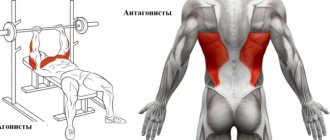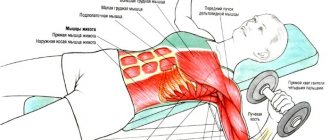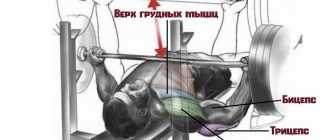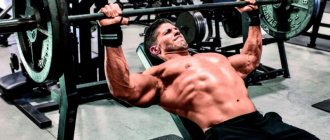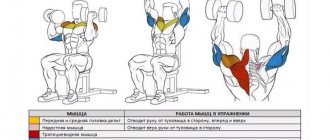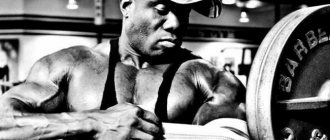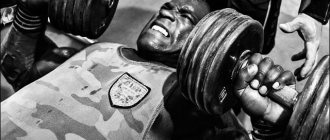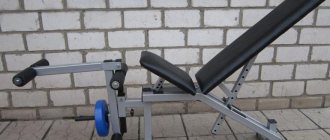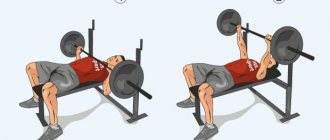Bridge in bench press: its advantages and relevance.
Advantage number 1
The main thing is the ability to include the latissimus dorsi muscles in the bench press, at the moment when the barbell is lowered to the chest.
Advantage number 2
The second benefit of the bridge in the bench press is less relevant for increasing the pectoral muscle, but is very relevant for increasing the weight on the bar. With this execution, the distance from the top point where you need to lift the barbell to your chest is slightly reduced. It follows from this that you will have to lift the barbell to a lower height from the chest, which will definitely be a plus.
Advantage number 3
When lowering the barbell to your chest while lying on the bridge, you automatically get the opportunity to have some shock absorption of the barbell from your chest, which can greatly help at the lowest, and therefore heaviest, point of amplitude, precisely at the initial moment when the barbell is removed from the chest. Everyone has ever bench pressed a barbell from the chest, they know that the most difficult thing to pass is the lowest point of the amplitude, which is also called the “dead point”. You can even hear the following expression: “Breaking through the dead center” or “The main thing is to get through the dead center.” This is exactly where the bridge in the bench press can help, which is the third significant advantage of the bridge in the bench press.
Description of the exercise
Basic exercise for chest training. There are many variations of this exercise. The picture shows a chest press. That is, the athlete works with one chest. With a “lifter” press, the main task of which is to squeeze out the maximum weight, the athlete involves as many muscles as possible in the work.
I do not recommend the “chest” bench press for non-professionals. Since this option is not designed for heavy weights and low repetitions. Well, what guy doesn’t like to bench press heavy weights 1-2 times! The “chest” bench press is best performed with light to medium weights for at least 6 to 8 repetitions. After all, it puts a lot of stress on the pectoral muscle tendon and the ligaments of the shoulder joint, and heavy weights will sooner or later lead to a shoulder or chest injury.
But the “lifter” bench press is designed for maximum weights and, other things being equal, is less dangerous. But it uses the pectoral muscles less. Less does not mean that they do not work with this technique.
Main features
1. To get used to the “bridge” in the bench press, you can initially place a soft cushion under your lower back. This will teach you to arch your back.
2. When you lie down on the bench, do it so that your eyes are under the bar. If you lie too deep, the bar may catch on the racks when you press. If it is too far, it will be inconvenient to place and remove the bar.
3. When placing the bar on the racks, make sure the bar is firmly on the racks before removing your hands. I have already seen 2 times how an athlete put the bar on the very edge, removed his hands, the bar fell off the racks and fell on his face. The spectacle is not for the faint of heart, let me tell you.
4. Use wrist wraps when working at 70% of your maximum weight or higher. Even if you have strong brushes. Over time, constant stress can lead to pain in the hands.
5. The bench press belt does absolutely nothing to prevent back injuries. It's just a fetish or a tribute to fashion.
6. Never press if you are alone in the room. Everyone has already talked about this thousands of times. The exception is those cases when you have a bench press with special safety racks (nowadays these are no longer uncommon).
7. Never throw the barbell on your chest. You must have complete control over the process of lowering the projectile. Otherwise, the result will be poor exercise performance and injury.
Subtleties of the technique of performing a bridge in the bench press
It goes without saying that when performing a bridge press, you should always remember the correct technique for performing the exercise. A lot of it has to do with the position of your feet. Under no circumstances should they just hang around the bench. In this exercise, as in many others, by the way, they should serve as a solid support and basis for you to perform the movement. Basically, you have to stand or lean, whatever you want to call it, on your feet and shoulder blades. As for the buttocks, in this exercise they should not serve as a support, but they should not hang over the bench. Your butt should just rest on the bench or even touch it as you bridge the bench press.
The correct technique for the bench press on the bridge, as in many other exercises, is needed not only to achieve the goal, but also, first of all, to avoid various types of injuries.
Execution technique
If you decide to work on strength, then you can try bench pressing using a bridge.
The chest press technique with a bridge is as follows:
- Starting position: lying on a horizontal bench, holding the barbell with a wide grip. Feet on the floor.
- The body is supported on the neck and legs. There is maximum deflection in the thoracic and lumbar regions. A stand on the shoulder blades and legs is performed, very similar to a wrestling bridge (hence the name). The pelvis only lightly touches the bench.
- Remove the barbell from the racks and smoothly lower it to your chest. Press the barbell upward, tensing the muscles of your legs, back and shoulder girdle.
I would like to note that this is a simplified version of the technique.
In powerlifting, it takes several months to develop a good bridge. And there are many other technical elements that need to be honed.
Therefore, if you are not going to do strength training, a simplified version will suffice.
Exercises that help develop a bridge in the bench press
Assistance exercises that can help develop the bridge and subsequently assume the correct bridge position for the bench press typically use classic wrestling or gymnastics bridges to develop the flexibility of your back. Which will then be very necessary for the bridge bench press. At first, you can use a thick roller for these purposes, which can even be made from a towel. It should be placed under the lower back, a little closer to the chest, when you are training to stand on the bridge. If you are interested in the correct squat technique or deadlift technique, I recommend reading these articles.
Another useful tip : when performing the bench press, try to squeeze your shoulder blades as tightly as possible every time you do a bridge and do not let go throughout the entire exercise. This will help you hold the bridge better and feel the pectoral muscles better and shift the load from the triceps and deltoids to the chest.
Bench press with or without bridge: difference and technical features
With a large deflection, the triceps work predominantly, so athletes who bench press for aesthetics should perform a low deflection in the thoracic region. A “flat back” is allowed if:
- Light weight is used;
- The athlete is recovering from an injury;
- A very wide grip is used, more than a competition grip.
If these conditions are met, the pecs and triceps can be worked out well. But to develop the entire shoulder girdle and build strength, a deflection is needed. The athlete chooses a bench press with or without a bridge based on priorities and the development of flexibility and mobility.
Epilogue
The bridge bench press is an exercise technique that is mainly suitable for professional powerlifters; we can say that it is the prerogative of powerlifting professionals. This technique is not simple and it is aimed at maximum results. Just like the stiff-legged deadlift, this is a very specific exercise. And if you are able to master it and practice it in training, then you will definitely get quite a lot of benefits. And even if you cannot do such a bridge when pressing, which is shown in the video below, then do not despair. And even if you just don’t have the desire to do such a bridge as in the video, then in any case the general rules for performing the bench press are the same for everyone. But the depth of the bridge is a purely individual matter, but it should be present in every athlete performing a bench press.
Bench press standards without and with equipment (2020)
The bench press exercise is used by athletes to develop (mainly) the muscles of the arms, back and chest. Performed with free weight. Its essence is that the athlete removes the barbell from a specially made riser with his arms completely straight, then bends his arms until the bar touches his chest, and then must again straighten his arms completely with the weight. The exercise is considered completed when the entire cycle is completed without errors. As a rule, such exercises are performed by weightlifters who are professionally involved in bodybuilding or powerlifting.
Depending on the weight, the method of lifting it, and the number of actions performed, different muscle groups develop. This is important if the bench press is practiced by bodybuilders, for whom the whole essence of training comes down to the harmonious development of muscle mass.
Men – AWPC category standards bench press – without equipment | |||||||||
| Weight category | Elite | MSMK | MS | KMS | I | II | III | I junior | II junior |
| 52 | 127.5 | 110 | 95 | 82.5 | 75 | 67.5 | 57.5 | 47.5 | 37.5 |
| 56 | 137.5 | 120 | 102.5 | 90 | 80 | 72.5 | 62.5 | 52.5 | 42.5 |
| 60 | 147.5 | 127.5 | 112.5 | 97.5 | 87.5 | 77.5 | 67.5 | 55 | 45 |
| 67.5 | 165 | 142.5 | 125 | 107.5 | 97.5 | 87.5 | 75 | 62.5 | 50 |
| 75 | 180 | 155 | 135 | 117.5 | 105 | 95 | 82.5 | 67.5 | 55 |
| 82.5 | 192.5 | 167.5 | 145 | 127.5 | 112.5 | 102.5 | 87.5 | 72.5 | 57.5 |
| 90 | 202.5 | 175 | 152.5 | 132.5 | 120 | 107.5 | 92.5 | 77.5 | 60 |
| 100 | 215 | 185 | 162.5 | 140 | 125 | 112.5 | 97.5 | 80 | 65 |
| 110 | 225 | 195 | 167.5 | 147.5 | 132.5 | 117.5 | 100 | 85 | 67.5 |
| 125 | 235 | 202.5 | 177.5 | 152.5 | 137.5 | 122.5 | 105 | 87.5 | 70 |
| 140 | 242.5 | 210 | 182.5 | 157.5 | 142.5 | 127.5 | 110 | 90 | 72.5 |
| 140+ | 250 | 215 | 187.5 | 162.5 | 145 | 130 | 112.5 | 92.5 | 75 |
Women - AWPC category bench press - bare | |||||||||
| Weight category | Elite | MSMK | MS | KMS | I | II | III | I junior | II junior |
| 44 | 62.5 | 55 | 47.5 | 40 | 37.5 | 32.5 | 27.5 | 22.5 | 20 |
| 48 | 70 | 60 | 52.5 | 45 | 40 | 37.5 | 32.5 | 27.5 | 22.5 |
| 52 | 77.5 | 67.5 | 57.5 | 50 | 45 | 40 | 35 | 30 | 25 |
| 56 | 82.5 | 72.5 | 62.5 | 55 | 47.5 | 42.5 | 37.5 | 32.5 | 27.5 |
| 60 | 90 | 77.5 | 67.5 | 57.5 | 52.5 | 47.5 | 40 | 35 | 30 |
| 67.5 | 100 | 85 | 75 | 65 | 57.5 | 52.5 | 45 | 37.5 | 32.5 |
| 75 | 107.5 | 92.5 | 80 | 70 | 62.5 | 57.5 | 47.5 | 40 | 35 |
| 82.5 | 115 | 97.5 | 85 | 75 | 67.5 | 60 | 52.5 | 42.5 | 37.5 |
| 90 | 120 | 102.5 | 90 | 77.5 | 70 | 62.5 | 55 | 45 | 40 |
| 90+ | 122.5 | 107.5 | 92.5 | 80 | 72.5 | 65 | 57.5 | 47.5 | 42.5 |
WPC
– World Powerlifting Congress, international powerlifting federation
AWPC
– Amateur World Powerlifting Congress, amateur league WPC, doping control is carried out on 10% of participants during competitions
Men – category standards WPC bench press – without equipment | |||||||||
| Weight category (kilogram) | Elite | MSMK | MS | KMS | I | II | III | I(yu) | II(yu) |
| 52 | 150 | 130 | 112.5 | 97.5 | 87.5 | 77.5 | 67.5 | 55 | 45 |
| 56 | 162.5 | 140 | 122.5 | 105 | 95 | 85 | 72.5 | 60 | 47.5 |
| 60 | 175 | 150 | 130 | 115 | 102.5 | 92.5 | 77.5 | 65 | 52.5 |
| 67.5 | 195 | 167.5 | 147.5 | 127.5 | 115 | 102.5 | 87.5 | 72.5 | 57.5 |
| 75 | 212.5 | 182.5 | 160 | 140 | 125 | 112.5 | 95 | 80 | 65 |
| 82.5 | 227.5 | 197.5 | 170 | 147.5 | 132.5 | 120 | 102.5 | 85 | 67.5 |
| 90 | 240 | 207.5 | 180 | 157.5 | 140 | 125 | 107.5 | 90 | 72.5 |
| 100 | 252.5 | 220 | 190 | 165 | 147.5 | 132.5 | 115 | 95 | 75 |
| 110 | 265 | 227.5 | 197.5 | 172.5 | 155 | 140 | 120 | 100 | 80 |
| 125 | 275 | 240 | 207.5 | 180 | 162.5 | 145 | 125 | 105 | 82.5 |
| 140 | 285 | 247.5 | 215 | 187.5 | 167.5 | 150 | 130 | 107.5 | 85 |
| 140+ | 292.5 | 252.5 | 220 | 192.5 | 172.5 | 155 | 132.5 | 110 | 87.5 |
Women - WPC category bench press - bare | |||||||||
| Weight category (kg) | Elite | MSMK | MS | KMS | I | II | III | I(yu) | II(yu) |
| 44 | 75 | 65 | 55 | 47.5 | 42.5 | 40 | 35 | 27.5 | 22.5 |
| 48 | 82.5 | 70 | 62.5 | 55 | 47.5 | 42.5 | 37.5 | 30 | 25 |
| 52 | 90 | 77.5 | 67.5 | 60 | 52.5 | 47.5 | 40 | 35 | 27.5 |
| 56 | 97.5 | 85 | 72.5 | 65 | 57.5 | 52.5 | 45 | 37.5 | 30 |
| 60 | 105 | 90 | 77.5 | 67.5 | 62.5 | 55 | 47.5 | 40 | 32.5 |
| 67.5 | 117.5 | 100 | 87.5 | 75 | 67.5 | 60 | 52.5 | 42.5 | 35 |
| 75 | 125 | 110 | 95 | 82.5 | 75 | 67.5 | 57.5 | 47.5 | 37.5 |
| 82.5 | 135 | 115 | 100 | 87.5 | 77.5 | 70 | 60 | 50 | 40 |
| 90 | 140 | 122.5 | 105 | 92.5 | 82.5 | 75 | 62.5 | 52.5 | 42.5 |
| 90+ | 145 | 125 | 110 | 95 | 85 | 75 | 65 | 55 | 45 |
Rank standards for men's bench press, WPC - single-layer equipment | |||||||||
| Weight category | Elite | MSMK | MS | KMS | I | II | III | I junior | II junior |
| 52 | 157.5 | 137.5 | 120 | 102.5 | 92.5 | 82.5 | 72.5 | 60 | 47.5 |
| 56 | 172.5 | 150 | 130 | 112.5 | 102.5 | 90 | 77.5 | 65 | 52.5 |
| 60 | 187.5 | 162.5 | 142.5 | 122.5 | 110 | 100 | 85 | 70 | 57.5 |
| 67.5 | 210 | 180 | 157.5 | 137.5 | 122.5 | 110 | 95 | 77.5 | 62.5 |
| 75 | 232.5 | 200 | 175 | 152.5 | 137.5 | 122.5 | 105 | 87.5 | 70 |
| 82.5 | 252.5 | 220 | 190 | 165 | 147.5 | 132.5 | 115 | 95 | 77.5 |
| 90 | 272.5 | 235 | 205 | 177.5 | 160 | 142.5 | 122.5 | 102.5 | 82.5 |
| 100 | 292.5 | 252.5 | 220 | 192.5 | 172.5 | 155 | 132.5 | 110 | 87.5 |
| 110 | 310 | 267.5 | 232.5 | 202.5 | 182.5 | 162.5 | 140 | 117.5 | 92.5 |
| 125 | 330 | 285 | 247.5 | 215 | 192.5 | 172.5 | 147.5 | 125 | 100 |
| 140 | 345 | 297.5 | 260 | 225 | 202.5 | 180 | 155 | 130 | 102.5 |
| 140+ | 355 | 307.5 | 267.5 | 232.5 | 210 | 187.5 | 160 | 135 | 107.5 |
Rank standards for women's bench press, WPC - single-layer equipment | |||||||||
| Weight category | Elite | MSMK | MS | KMS | I | II | III | I junior | II junior |
| 44 | 80 | 70 | 60 | 52.5 | 47.5 | 42.5 | 37.5 | 30 | 25 |
| 48 | 90 | 77.5 | 67.5 | 60 | 52.5 | 47.5 | 40 | 35 | 27.5 |
| 52 | 100 | 85 | 75 | 65 | 57.5 | 52.5 | 45 | 37.5 | 30 |
| 56 | 107.5 | 92.5 | 80 | 70 | 62.5 | 57.5 | 47.5 | 40 | 32.5 |
| 60 | 115 | 100 | 87.5 | 75 | 67.5 | 60 | 52.5 | 42.5 | 35 |
| 67.5 | 130 | 112.5 | 97.5 | 85 | 75 | 67.5 | 57.5 | 47.5 | 40 |
| 75 | 140 | 122.5 | 105 | 92.5 | 82.5 | 75 | 62.5 | 52.5 | 42.5 |
| 82.5 | 150 | 130 | 112.5 | 97.5 | 87.5 | 80 | 67.5 | 57.5 | 45 |
| 90 | 160 | 137.5 | 120 | 105 | 92.5 | 82.5 | 72.5 | 60 | 47.5 |
| 90+ | 162.5 | 142.5 | 122.5 | 107.5 | 95 | 85 | 75 | 62.5 | 50 |
Rank standards for men's bench press, WPC - multi-layer equipment | |||||||||
| Weight category | Elite | MSMK | MS | KMS | I | II | III | I junior | II junior |
| 52 | 165 | 142.5 | 125 | 107.5 | 97.5 | 87.5 | 75 | 62.5 | 50 |
| 56 | 180 | 155 | 135 | 117.5 | 105 | 95 | 82.5 | 67.5 | 55 |
| 60 | 195 | 170 | 147.5 | 127.5 | 115 | 102.5 | 87.5 | 72.5 | 60 |
| 67.5 | 225 | 192.5 | 167.5 | 147.5 | 132.5 | 117.5 | 100 | 85 | 67.5 |
| 75 | 250 | 215 | 187.5 | 162.5 | 145 | 130 | 112.5 | 92.5 | 75 |
| 82.5 | 272.5 | 235 | 205 | 177.5 | 160 | 142.5 | 122.5 | 102.5 | 82.5 |
| 90 | 292.5 | 252.5 | 220 | 190 | 170 | 152.5 | 132.5 | 110 | 87.5 |
| 100 | 312.5 | 270 | 235 | 205 | 185 | 165 | 142.5 | 117.5 | 95 |
| 110 | 332.5 | 287.5 | 250 | 217.5 | 195 | 175 | 150 | 125 | 100 |
| 125 | 352.5 | 305 | 265 | 230 | 207.5 | 185 | 160 | 132.5 | 105 |
| 140 | 370 | 320 | 277.5 | 242.5 | 217.5 | 195 | 167.5 | 137.5 | 110 |
| 140+ | 382.5 | 330 | 287.5 | 250 | 222.5 | 200 | 172.5 | 142.5 | 115 |
Rank standards for women's bench press, WPC - multi-layer equipment | |||||||||
| Weight category | Elite | MSMK | MS | KMS | I | II | III | I junior | II junior |
| 44 | 87.5 | 77.5 | 67.5 | 57.5 | 52.5 | 47.5 | 40 | 32.5 | 27.5 |
| 48 | 97.5 | 85 | 75 | 65 | 57.5 | 52.5 | 45 | 37.5 | 30 |
| 52 | 107.5 | 95 | 82.5 | 70 | 62.5 | 57.5 | 50 | 40 | 32.5 |
| 56 | 117.5 | 102.5 | 87.5 | 77.5 | 70 | 62.5 | 52.5 | 45 | 35 |
| 60 | 127.5 | 110 | 95 | 82.5 | 75 | 67.5 | 57.5 | 47.5 | 37.5 |
| 67.5 | 142.5 | 122.5 | 107.5 | 92.5 | 82.5 | 75 | 65 | 52.5 | 42.5 |
| 75 | 155 | 132.5 | 115 | 100 | 90 | 82.5 | 70 | 57.5 | 47.5 |
| 82.5 | 165 | 142.5 | 125 | 107.5 | 97.5 | 87.5 | 75 | 62.5 | 50 |
| 90 | 175 | 150 | 130 | 115 | 102.5 | 92.5 | 77.5 | 65 | 52.5 |
| 90+ | 180 | 155 | 135 | 117.5 | 105 | 95 | 80 | 67.5 | 55 |
What are the judges looking for?
Of course, knowledge of the technique alone is not enough to flawlessly fulfill the standard. Very often, young and energetic athletes remain out of work due to the fact that they simply do not adhere to certain rules by which such strength exercises should be performed. In this case, even if the athlete is actually able to lift the weight assigned to him, even a slight deviation from the stipulated procedure may cost him a failure.
Therefore, in addition to the basic technique, it is worth paying attention to the following points:
- the judge should always be located at the head of the athlete in order to fully view the process of performing the exercise;
- the athlete must lie completely on a special bench, the buttocks of his body are prohibited from being torn off the bench while lifting weights, his legs must be in full contact with the floor surface at all times, his head is positioned according to the athlete’s convenience;
- in order to get normal support for the legs, and this is very important due to the different heights of athletes, it is allowed to use blocks or discs as a basis. With their help, a small graveyard is performed so that the legs of the person squeezing the barbell completely touch the support when the exercise is performed;
- to support (insure) the athlete during the procedure of squeezing the barbell, the presence of up to 4 insurers is allowed (their responsibilities include assistance when it is necessary to remove the barbell from the racks, insurance during the bench press itself, returning the barbell to its original fixed and safe position after completing the necessary manipulations with the weight , at the same time, assistants should not block the view of what is happening to the judge recording the execution of the exercise);
- the maximum arm spread distance on the bar should be within 81 cm, for this there are special notches, the initial grip is discussed with the judge, and should also ensure the safety of the athlete during the bench press (especially important when lifting a large weight);
- after the start of the procedure for power lifting the barbell, when the projectile is given to the athlete with outstretched arms, he must lower the weight to his chest and lift it back at the command of the judge, who records the achieved result;
- as a rule, the signal should be given by the judge as soon as the bar reaches the chest and is fixed there in a stationary position, usually the voice command “press” is given;
- Only one signal is given to start the action. If you don’t have time to get your bearings, the exercise will not be counted;
- the exercise is considered completed when, after the “press” command, the athlete completely squeezes all the weight previously lowered onto the chest onto the outstretched forelimbs.
The exercise must be performed under the supervision of a judge with the opportunity to review all the nuances of the actions performed. To do this, assistants must be located on both sides of the ends of the bar in order to enable the referee to fully perform his duties.
A little about the most common mistakes
Now a little about why the exercise may not be counted, and the athlete will simply waste his efforts and the time of the panel of judges. Among the most common mistakes are the following:
- the athlete ignores the judge’s commands or is in a hurry in the process of executing such commands;
- violation of the athlete’s position before starting the bench press, in particular, lifting the buttocks off the bench, incorrect positioning of the legs, incorrect (asymmetrical) positioning of the hands on the bar is a gross violation, due to which the exercise is considered not completed;
- if the barbell is knocked away from the chest while trying to lift it;
- when, having received the judge’s signal to perform an upward press, the athlete’s barbell begins to sag further down, pressing against his chest;
- in the case when, during a bench press, the arms begin to straighten unevenly upward (first one, then the other);
- if between the signals given by the judge (from the moment the press begins until the final signal is given to stop and fix the exercise performed), the assistants even accidentally touch the bar;
- when the athlete even accidentally lifts his legs off the floor and touches the bench supports with his feet;
- in the case when, during a bench press, an athlete even accidentally touches the support posts with the barbell in order to reduce the load when performing the exercise;
- violation by the assistant referee of the requirements to immediately leave the observation deck during the exercise.
A little about the technique of performing this exercise
To avoid various injuries, as well as to obtain the desired effect in a short period of time, you must adhere to a certain technique for performing the exercise. In this case, the following nuances should be taken into account:
- the bench on which the athlete will lie must be strong, hard, stable and located at an angle of 0 to 30 degrees towards the athlete’s head;
- the bar with the required weight is installed on special racks or limiters;
- the athlete must lie on the bench so that his eyes are located directly under the bar;
- to obtain greater stability, you need to spread your legs wide and rest your feet on the floor (your shins should be perpendicular to the floor);
- if the bench is flat, the back is arched to its natural length; in the case of an inclined plane of the bench, the body is pressed tightly against the bench;
- when gripping the bar, the shoulders should be perpendicular to the floor, the grip can be wide or narrow, the exercise is usually performed with an assistant;
- if the bench press is horizontal, the bar should fall slightly below the nipples, with an inclined press, between the nipples and collarbone;
- after completing the bench press exercise, the barbell returns to the racks (this exercise must be performed with an assistant, or in his presence).
Remember, bench press exercises with a large weight must be performed with the presence of at least one assistant, so that if it is impossible to lift the weight to the starting position, someone can help you with this.
If it is not possible to attract such an assistant, familiarize yourself with the technique of how to perform an emergency termination of the exercise (in this case, the weights are not fixed, the barbell is carefully lowered onto the chest, and then its position is slightly changed so that the weights on one side have the opportunity to jump off, and then the weight is removed in the same way from the other side of the barbell. Ultimately, one bar should remain in the athlete’s hands).
Bridge in bodybuilding
For bodybuilders, the main role is played not by strength, but by muscle volume, so they do not use a bridge in their training.
- If you want to have a massive chest, then when bench pressing as much of the load as possible should fall on it, and not be distributed throughout the body. And to avoid stress on the back and legs, the buttocks must be pressed tightly against the bench. The deflection should only be in the lumbar spine,” comments Sergei Yugay, bronze medalist of the open bodybuilding championship of North-West Russia .
Work of muscles and joints
During a power press, many more muscle groups are used than during a classic bench press without a bridge, since the inclusion of a large number of muscle groups is, in fact, the task that the bridge performs. The load is placed on the legs, latissimus dorsi, triceps, anterior deltoids, biceps and the lower part of the pectoralis major muscle. In fact, the bridge press does not load the chest that much and only in a short segment of the range of motion. In the lower phase, while the elbow is behind the line of the body, the latissimus dorsi muscle takes on the load, since its function is to bring the arm to the body. Then the lower bundle of pectoral muscles is connected, and then the load smoothly goes to the anterior delta and triceps. The legs, abs and longus dorsi work as stabilizers throughout the entire range of motion, and the biceps are actively involved in the negative phase when the lifter lowers the barbell to the chest.
There are many joints involved during a power press; this is a basic multi-joint exercise. The load is distributed between the elbow and shoulder joints, thereby eliminating the possibility of injury. Of course, you can get injured anytime and anywhere, but by distributing the load between several joints, the likelihood of injury is significantly reduced. There is also one very important rule - the barbell must be handed to you, because when you independently remove it from the racks, the shoulder joint is in an unnatural position for it and the entire load falls on it and the anterior deltoid, so this should be avoided if possible. In addition, in your bench press training , you should generally use the help of a partner who can back you up and help you perform many different interesting exercises that help increase strength.
